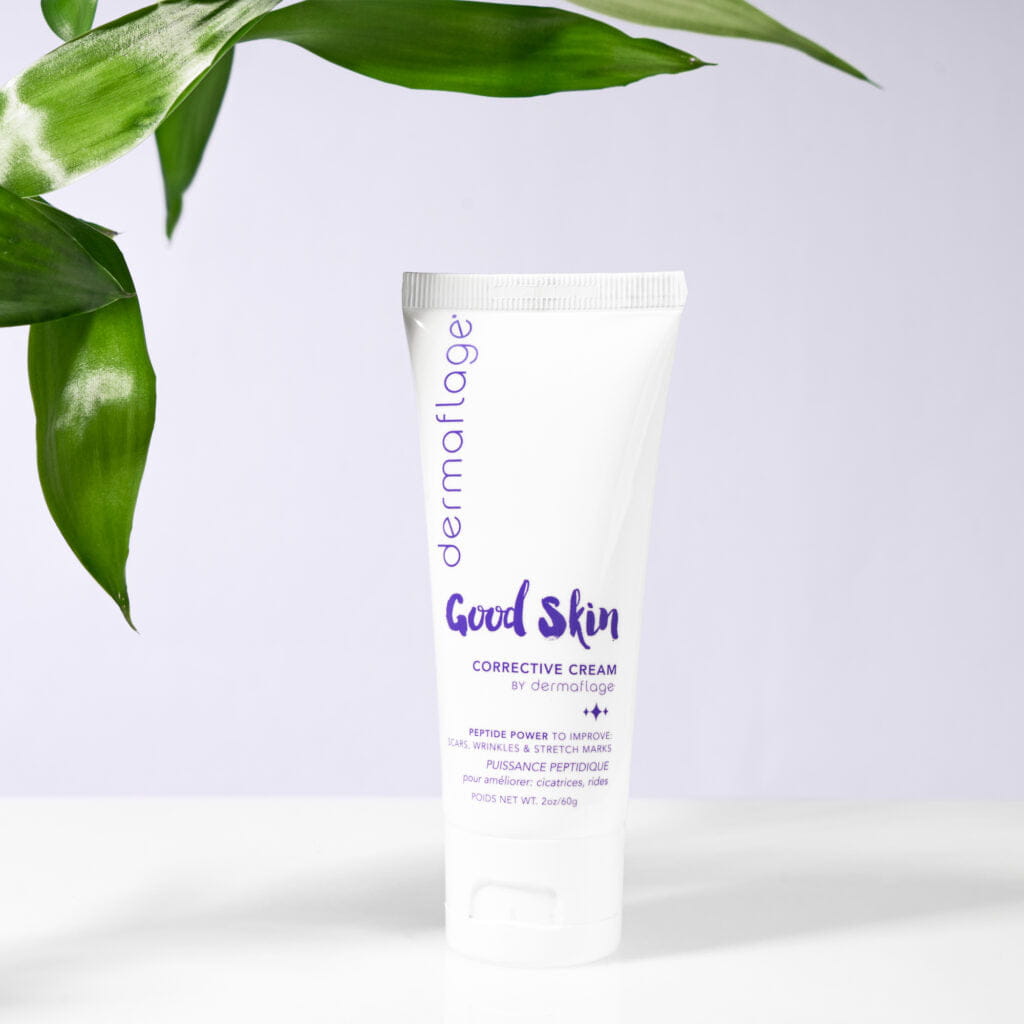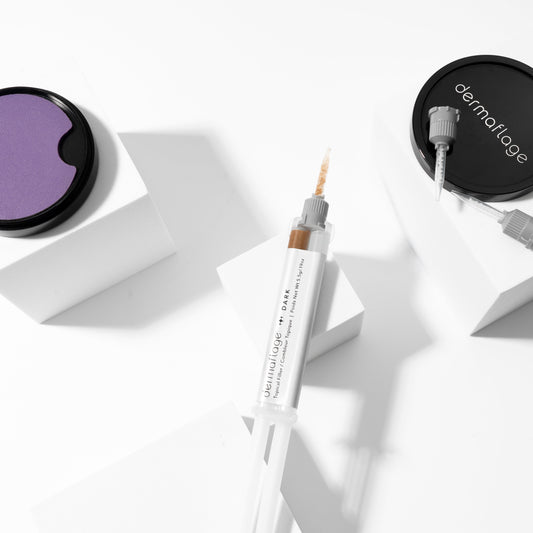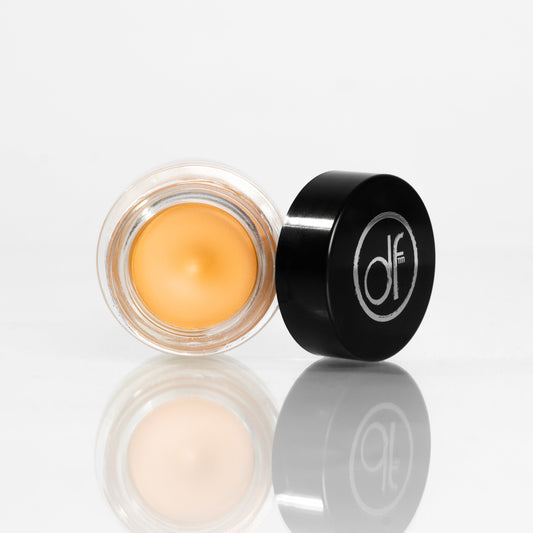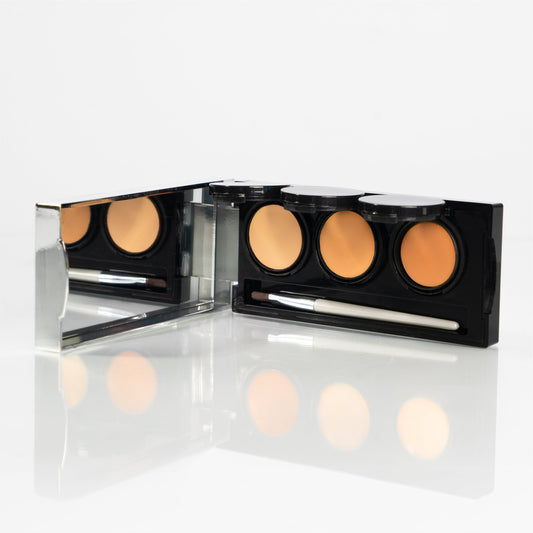
A surgery scar forms as the body’s natural way of healing after a procedure. A surgery scar may appear tight, bumpy, elevated, or feel hard to the touch. While surgical skin treatments may seem like the best option to mask surgical scars, there are less invasive alternatives you can consider too. Products such as the Dermaflage Behind the Scenes Concealer can do wonders to cover up surgery scars.
That said, it’s essential to follow the advice of your healthcare provider on how to care for a surgery scar. The way a surgery scar looks depends on factors such as age, the severity of the scar, and where it is placed on the body. There are many scar creams on the market but you want to look for those with effective ingredients, such as peptides.
Revealing a surgery scar can bring up questions you’re not comfortable answering or be a troubling reminder of an injury. We’re here to help you understand how to cover up the appearance of a surgery scar and feel more confident in your skin.
How Long Until Surgery Scars Heal?
It can take anywhere between 12 to 18 months for a surgery scar to heal. But, remember that while there are ways to minimize its appearance, there’s no sure-shot solution to eliminate a surgery scar completely. As the surgery scar heals, you’ll notice it appears less inflamed, not as reddened, and smoother to the touch.
Types of Scars
Surgery scars settle across the skin differently, depending on how the body reacts to the healing process. Here are how surgery scars commonly appear.
Hypertrophic
This type of skin appears raised and red and doesn’t go away easily. These scars remain isolated to the area where the surgery took place.
Contractures
This type of scar makes it a challenge to move muscles and tendons with ease. They appear puckered and are often left behind by burns. Depending on the severity of the burns, the scars can go deep enough to also affect muscles and nerves underneath the skin.
Keloid
Fibrous and tough, keloid scars are itchy, thick, and red. This type of scar may sometimes grow larger with time and restrict movement. Keloid scars are typically a common occurrence in dark-skinned people.
Atrophic
Atrophic scars appear as indented scars when the top layer of the skin doesn’t heal the way it’s supposed to. They can form as a result of chickenpox, mole removal, acne, or MOHs construction (the removal of facial skin cancer). There are three kinds of atrophic scars: Flat scars that look like chickenpox scars called boxcar scars, deep scars caused after severe acne called icepick scars, and scarring on the cheeks that resemble rolling scars.
The Dermaflage Conceal & Heal Filler Bundle is a non-invasive alternative to surgical or cosmetic procedures for atrophic scars. It contains a topical solution that helps conceal the scars while allowing the skin to heal under a silicone layer.
Scar Surgery Removal Options
Before you start looking for plastic surgery for scars on face options, take the time to care for your scars after a procedure. This will help your skin heal better and even make plastic surgery an unnecessary course of action.
Some people opt for scar revision, a minimally invasive alternative to plastic surgery. This option involves a mix of topical treatments, wound closure techniques, and sometimes filler injections to plump pitted surgery scars (areas where the skin sinks).
While scar revision can minimize the appearance of a surgery scar, it won’t completely erase its existence. But yes, scar revision has the desirable cosmetic outcome in that it can soften the appearance of a surgery scar.
Scar Removal Surgery Cost
The cost of removing a surgery scar will depend on factors such as the clinic’s location, the scar’s severity, the number of surgery scars you have, the type of procedure you choose, and whether a doctor or esthetician will be attending to you.
Scar revision treatments are tailored to an individual’s situation and can cost between $500 and $2000 (or more). Chemical peels for surgery scar removals can cost up to $1200 per session.
How to Fade Surgery Scars
https://www.pexels.com/photo/person-putting-lotion-on-leg-7466779/
Surgery scars need care and time to heal. It’s important to start looking after surgery scars right after a procedure to support the healing stage.
Shield Scars From Sunlight
When you step outside in the sun, it’s crucial to wear sunscreen. Not wearing SPF can increase the production of melanin in the skin, causing it to darken over time. Similarly, a surgery scar needs to be protected from sun exposure. The last thing you want is for a surgery scar’s pigmentation to deepen.
Before you step outside:
- Apply sunscreen that offers protection against both UVB and UVA rays. Look for a PA++++ rating for maximum efficacy. Slather sunscreen all over your skin, focusing on the areas on and around your surgery scar. Sunscreen should always be bought from a trusted brand or as advised by a dermatologist
- Wear a wide-brim hat and sunglasses. Wear gloves or long-sleeve tops if the scars are on your hands or arms.
- Opt for long pants if the scars are on your legs
Use Silicone Gels and Sheets
Keeping a surgery scar moisturized will help it heal better. Silicone-based products can be worn under sunscreen and makeup at any time of the day. To soften rigid surgery scars, place silicone sheets on target areas. Cut the sheet to cover the length or breadth of your surgical scar. These sheets can be left overnight on the surgery scar and even for several hours.
Look for silicone sheets with ingredients such as Centella Asiatica (or Cica), peptides, vitamin E, and ceramides. Some brands make silicone gels that dry once left on the surgery scar. Apply such gels twice a day to keep the area moisturized.
Massage the Surgery Scar
Massage the surgery scar to loosen its rigidity and encourage better healing. Do this gently for 1 to 2 minutes once or twice a day.
Minimizing the Appearance of Surgery Scars with Dermaflage

At Dermaflage, we understand that surgery scars can make you feel conscious about your appearance. Our skincare formulations contain gentle, regenerative ingredients that, when used consistently, have the potential to transform the appearance of your skin.
Feel confident, beautiful, and empowered in your skin with our scar-concealing makeup products. They settle seamlessly over the skin, offering highly pigmented coverage to mask discolorations from surgery scars.
Instead of turning to treatment options that can be heavy on the pocket, let Dermaflage help you with those surgical scars.
Dermaflage Scar Cream
Lightweight and rich in moisturizing ingredients, the Dermaflage Scar Cream is a corrective formula composed of Hyaluronic acid (attracts moisture), peptides (provides deep moisture), and antioxidants (encourages cell renewal and promotes skin brightening).
The powerful blend of ingredients in this surgery scar removal cream help boost collagen production and safeguard against free radicals (toxins produced by the body because of stress, disease, or the environment). It’s the next best scar treatment after surgery that supports gradual healing.
Why You’ll Love It:
- A lightweight cream that is suitable for dry, oily, acne-prone, and sensitive skin
- Non-greasy formula that the skin will soak up gladly
- Instantly moisturizes the skin
- Doubles as a primer and can be worn under makeup for long-lasting wear
- Contains three kinds of peptides that promote skin collagen synthesis and halt scar growth and maturation
Behind the Scenes Dermaflage Concealer
Creamy and super pigmented, the Dermaflage Behind the Scenes Concealer is not your regular makeup product. The professional formula masks scars, discoloration, bruises, acne marks, and even tattoos.
Why You’ll Love It:
- Smudgeproof and waterproof
- Doesn’t transfer to clothes
- Your skin won’t feel tacky to the touch
- Sets into a matte finish
- Can be worn over sunscreen and under foundation or primer
- Easy to carry in your handbag
How to Apply
Simply apply the Dermaflage concealer to the area you want to mask. Tap the formula gently across your skin with a blending brush or your fingers. For more coverage, go in with a second layer of concealer. You can apply the concealer on its own or over a lightweight foundation.
Conceal & Heal Filler Bundle
The bundle contains the Dermaflage Scar Filler and the Dermaflage Good Skin Scar Removal Cream. These products are formulated to help conceal and support the healing of scars over time. The scar filler is available in a range of skin color tones, making it easy to conceal scars during the day. A good nighttime skincare routine is incomplete without the Dermaflage Good Skin Scar Removal Cream, a silicone-based formula enriched with the goodness of peptides.
Why You’ll Love It:
- With regular use, the formula quickens the healing time of surgery scars, stretch marks, older scars, and acne scars
- Contains peptides that encourage collagen production, improve skin resilience, and minimize scarring
- Safe for sensitive skin
- Suitable for aging skin
Final Thoughts
Surgery scars may not go away completely with traditional treatment methods, but they can be cared for and masked with the right products. Give your surgery scars the love and attention they need with Dermaflage





